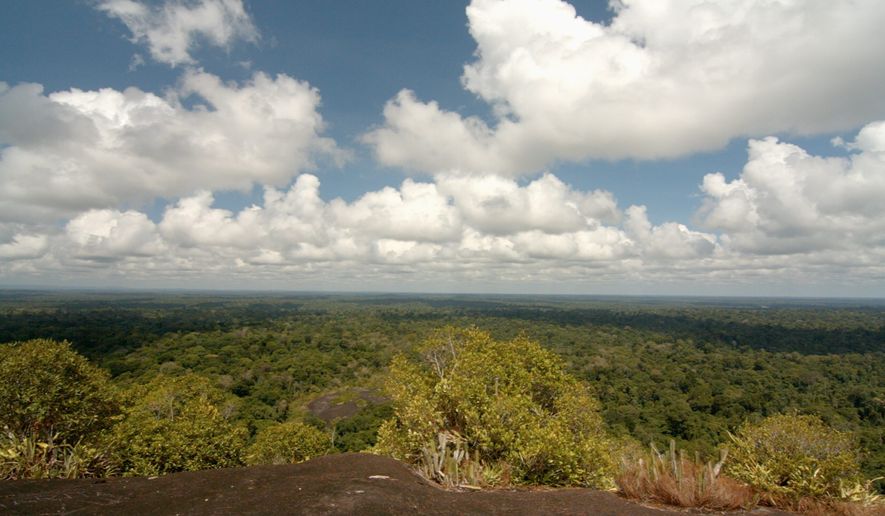Suriname prides itself on being the “greenest” country on Earth and it intends to stay green as it ramps up its oil and mining industries, say government officials.
Famous for its pristine rainforest and rivers, resource-rich Suriname is welcoming foreign direct investment to ramp up its oil and mining industries; they account for more than 40 percent of GDP and some 94 percent of export revenue. The goal is to use extra revenues from oil and mining (gold mining in particular) to develop sectors seen as more sustainable and appropriate in the long-term, namely: agriculture, forestry, fisheries, tourism and services. Those extra revenues also will fund improvements in among others education, health care and housing in the currently upper middle-income country.
The four-year-old government of President Desir Bouterse has a “socially motivated agenda” and considers these policies vital to the South American nation’s long-term sustainable development path, explained Minister of Natural Resources Jim Hok.
Referring to potential conflicts between long-standing environmental policies and development, the Minister of Natural Resources Jim Hok stated : “We are working to maintain a balance.” Suriname currently has dedicated 13.7% of its surface to conservation in order to protect headwaters, biodiversity and key ecosystem services.
There are good reasons for moving ahead cautiously. Suriname has a land mass of 63,000-square miles - about the size of Florida - and is a naturalist’s paradise. It is South America’s smallest sovereign country - yet it has up to eight percent of the world’s pristine tropical forests, and its rivers carry about 10 percent of the fresh water of rivers worldwide.
Rainforests like Suriname’s also play an important role in keeping the global ecosystem healthy; they absorb carbon dioxide from man-made activities and produce breathable oxygen. These absorbed greenhouse gases contribute to global warming, a phenomena that could cause havoc in low-lying coastal nations like Suriname.
Suriname has environmentally friendly policies, which now prove to be instrumental to combat rising temperatures. Suriname’s diplomats, both in the United Nations and other venues, have issued clarion calls to combat climate change; Suriname has 239 miles of low-lying coastline. “Suriname is listed as one of the seven most vulnerable countries in respect to climate change induced sea-level rise,” noted Rabindre Parmessar, Suriname’s Minister of Public Works, at last month’s UN Climate Summit in New York.
If global temperatures keep rising, Suriname could suffer the negative effects of climate change in as little as 15 years; and rising sea-levels would be disastrous for our low-lying coastal area, Parmessar said. “This means that Paramaribo - Suriname’s capital of which the Inner City has been proclaimed as a UNESCO World Heritage Site - would most likely disappear, unless we spend an inordinate amount of our current and future GDP to protect ourselves against the inevitable impacts of sea-level rise.” In this regard, Suriname has already built embankments on Paramaribo’s river shores to protect its capital, where 40 percent of its inhabitants live.
Acutely aware of these worst-case scenarios, Suriname’s officials have embraced an international mechanism designed to reduce greenhouse gases. It does this by stopping the destruction of rainforests, and hence the mechanism’s acronym: REDD+ which stands for “Reducing Emissions from Deforestation and Forest Degradation.” Created by the United Nations Framework Convention on Climate Change (UNFCCC), the objectives of REDD+ are to combat climate change with rules for the responsible management of forests in developing countries.
Even as Suriname ramps up mining and oil production, it has pledged to continue adhering to REDD+, which it regards as an important tool for sustainable development and a planning mechanism for the responsible use of its natural resources. “The development of Suriname’s REDD+ strategy is currently in full swing, and will be brought about by an inclusive, participatory process that respects the traditions, livelihoods and cultures of her rich and diverse population,” said Cedric Nelom, Acting Director of the National Institute for Environment and Development (NIMOS), who is currently managing the REDD+ program in Suriname.
Protecting Suriname’s rainforest also plays an important role in combating climate change. “The Surinamese forests are currently absorbing more carbon dioxide than the country is emitting, effectively making Suriname one of the few carbon negative countries in the world,” he said.
Regarding its abundance of fresh water, Suriname also is “seriously looking” for ways to provide fresh water to Caribbean countries suffering shortages of fresh water, John Goedschalk, Advisor to the President on environment, noted. Ideally, exporting fresh water would diversify Suriname’s economy and benefit water-scarce countries by reducing their dependence on importing bottled water and operating desalination plans powered by carbon-producing fuels - activities that “suppress development” because of their high costs and negative environmental impact, Goedschalk said.
He added, “We are moving forward and are striving to do all that we can locally to ensure that we do in fact remain the greenest country on Earth.”
• This article was produced in conjunction with The Washington Times International Advocacy Department.




Please read our comment policy before commenting.